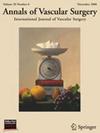Fenestrated Endovascular Aortic Aneurysm Repair Is Associated with Increased Sac Regression on Postoperative Volumetric Analysis Compared to Endovascular Aortic Aneurysm Repair
IF 1.4
4区 医学
Q3 PERIPHERAL VASCULAR DISEASE
引用次数: 0
Abstract
Background
Endovascular aortic aneurysm repair (EVAR) is utilized to treat abdominal aortic aneurysms, while patients with short infrarenal necks can undergo fenestrated EVAR (FEVAR). Previous studies have demonstrated decreased aortic neck dilation for FEVAR compared to EVAR. Sac regression is a marker of success after EVAR; however, little is known regarding changes in sac volumetrics. This study compares aortic sac regression after EVAR versus FEVAR using volumetric analysis.
Methods
A retrospective review of prospectively collected data from 120 patients who underwent EVAR was performed. Thirty patients underwent FEVAR (Cook Medical Inc, Bloomington, IN) and 90 patients underwent EVAR (30 each with Endurant [Medtronic, Dublin, Ireland], Excluder [Gore, Flagstaff, AZ], and Zenith [Cook]). Demographic data were analyzed. Using 3-dimensional reconstruction software, preoperative and postoperative aneurysm sac volumes were measured, in addition to aneurysm characteristics.
Results
There were no differences in demographic or preoperative comorbidities. Preoperatively, FEVAR had greater percentage of thrombus within the sac by volume compared to EVAR (51.5% vs. 39.1%, P = 0.0002), and greater overall sac volume (240.8 ± 100.4 vs. 188.2 ± 82.4 cm3, P = 0.005). EVAR patients had greater number of lumbar arteries (7.26 ± 1.68 vs. 5.31 ± 1.93, P < 0.000001). On postoperative follow-up, FEVAR cases had greater sac regression compared to standard EVAR (−22.75 ± 25.7% vs. −5.98 ± 19.66%, P = 0.00031). The percentage of sac regression was greater when measured by volume compared to maximum diameter for FEVAR (−22.75 ± 25.7% vs. −13.90 ± 15.4%, P = 0.01) but not EVAR (−5.98 ± 19.7% vs. −4.51 ± 15.2%, P = 0.246). Those in the top tertile of percent volume of thrombus (>48.5%) were more likely to experience greater than 10% sac regression by volume (55% vs. 33.3%, P = 0.015). On multivariate analysis, FEVAR was associated with sac regression greater than 10% by volume (odds ratio [OR] 4.325, 95% confidence interval [CI] 1.346–13.901, P = 0.014), while endoleak (OR 0.162, 95% CI 0.055–0.479, P < 0.001) and 2 patent hypogastric arteries (OR 0.066, 95% CI 0.005–0.904, P = 0.042) were predictive against.
Conclusions
Fenestrated EVAR is associated with greater sac regression compared to EVAR on volumetric analysis. This difference may be attributable to decreased endotension within the aneurysm resulting from less aortic neck dilatation, while the greater proportion of thrombus may be a protective factor from growth. Patients being evaluated for EVAR with borderline neck anatomy should be considered for FEVAR given increased sac regression.
求助全文
约1分钟内获得全文
求助全文
来源期刊
CiteScore
3.00
自引率
13.30%
发文量
603
审稿时长
50 days
期刊介绍:
Annals of Vascular Surgery, published eight times a year, invites original manuscripts reporting clinical and experimental work in vascular surgery for peer review. Articles may be submitted for the following sections of the journal:
Clinical Research (reports of clinical series, new drug or medical device trials)
Basic Science Research (new investigations, experimental work)
Case Reports (reports on a limited series of patients)
General Reviews (scholarly review of the existing literature on a relevant topic)
Developments in Endovascular and Endoscopic Surgery
Selected Techniques (technical maneuvers)
Historical Notes (interesting vignettes from the early days of vascular surgery)
Editorials/Correspondence

 求助内容:
求助内容: 应助结果提醒方式:
应助结果提醒方式:


